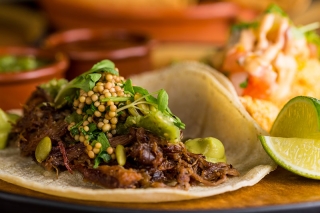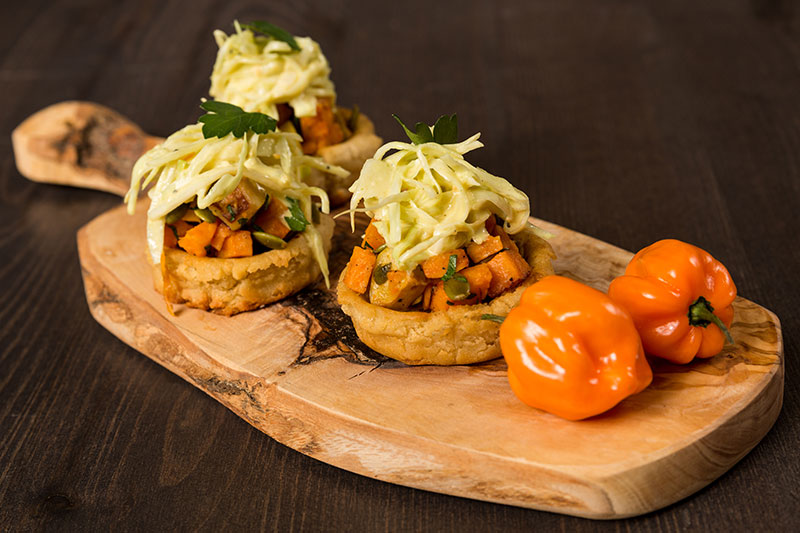
Pass the Mustard and Know the Facts
06 September 2020Teaching mustard’s flavor and heat: More than just a spice and hotdog condiment.
By Lisa Parrish, GMC Editor
Feedback & comments: This email address is being protected from spambots. You need JavaScript enabled to view it.
 How many prepared mustards can you name? Culinary students likely will only cite the top two: yellow and brown. Now, venture a guess on how many prepared mustards exist? The answer: limitless. Although there only three mustard seeds that form the flavor platform of prepared mustard, the seeds can be combined with limitless liquid bases to form an untold array of prepared mustards. And that’s just the beginning of teaching mustard in a culinary curriculum.
How many prepared mustards can you name? Culinary students likely will only cite the top two: yellow and brown. Now, venture a guess on how many prepared mustards exist? The answer: limitless. Although there only three mustard seeds that form the flavor platform of prepared mustard, the seeds can be combined with limitless liquid bases to form an untold array of prepared mustards. And that’s just the beginning of teaching mustard in a culinary curriculum.
Mustard: spice and condiment
Mustard is usually considered a spice or condiment. But, for some it’s a food ingredient. As a spice, mustard is the seed of the mustard plant. Throughout history dating back to the Middle Ages, mustard seed was used as a flavoring agent, for food preservation, and for medicinal purposes. Mustard is also an ingredient of many processed meats.
As a condiment, mustard adds flavor dimension. By definition, a condiment is a savory, piquant, spicy or salty accompaniment to any dish. Condiments can be added by the diner, added prior to serving or used in cooking to flavor the dish.
Yellow mustard is the white or yellow seed-coat color version of the Brassica Juncea plant grown by Saskatchewan mustard producers in Canada. It not only produces America’s favorite mustard – prepared yellow mustard – it is also a functional food ingredient known for its binding capabilities and emulsification properties which are important in making foods such as salad dressings. It is the most mellow-flavored mustard with minimum heat.
Brown mustard seed is used in Dijon-style mustards and is reddish-brown to dark brown in color. The oil content of brown seed is on average 36 percent. Brown mustard is zestier and often the base for hotter preparations.
Oriental mustard is a yellow to dark yellow color seed used extensively in oriental mustards and cooking oil. Oriental mustard seed, containing on average 36 percent oil, has the most piquant flavor of all mustards and is a common ingredient in Far Eastern cuisine.
Prepared mustards are a fluid mix of whole, cracked or ground mustard seed combined with vinegar, wine, beer or freshly pressed fruit juice known as must. Some mustard preparations leave in the hull and bran portion of the seed to create different textures.
Dry mustard powder, finely ground seed of the mustard plant, can be referred to as mustard flour, ground mustard or mustard seed powder. No matter the name, the product is essentially the same. What may be different is the product’s degree of fineness or coarseness. The powder’s heat will depend on the ratio of seed types used.
Click here to watch a short video on the types of mustard.
Mustard teaching tip
Have students smell and taste dry mustard powder and note its characteristics. Then, moisten it and have them smell and taste it again paying close attention to the differences. Liquid is required to develop its pungency and sharp flavor.
Prepared mustards around the world
Generally speaking, American-style prepared mustard is the mildest of mustards. Chinese mustards are hotter than other mustards. German mustards range from very hot to sweet and mild. The most commonly recognized French mustard is the tangy Dijon mustard. Other flavors include sweet and honey mustards, sweet and hot mustards, hot pepper mustards, horseradish mustards, spirit mustards, spicy mustards and the most well-known US favorite ballpark mustard. Prepared mustard textures range from very smooth to coarse and grainy to please any palate.
Mustard facts
Mustard acts as an emulsifier and retains moisture. It can be added to stir fries and sautés to bring the liquids together as a sauce. Mustard can also coat meat or poultry pieces when roasting or grilling. The spice forms a crust that retains juices within.
Here are tips for storing mustard:
- Mustard seed keeps well in a tightly sealed container stored in cool dry place for up to one year.
- Dry mustard powder keeps well in a tightly sealed container stored in cool dry place for up to six months.
- Store opened prepared mustards in the refrigerator for up to six months.
- Like other spices, mustards lose some of their zip as they age.
Toasting mustard seed can often round out its flavor and aroma. After toasting, the seed develops a nutty essence and crunch. Toasted mustard seed makes a nice garnish for appetizers, salads and main courses.
To toast mustard seed, heat a heavy skillet over medium heat until hot. Add 1/4 cup mustard seed. Toast two to five minutes, stirring constantly until fragrant and lightly browned, removing from heat when seeds start to pop. Another option is to heat the oven to 350° and toast the mustard seed on baking sheet for five minutes.
Cracking mustard seed
To crack mustard seed, place seed (no more than 1/2 cup) in a heavy freezer bag. Crush with a rolling pin, heavy skillet or the flat side of the meat mallet.
Grinding mustard seed
To grind by hand, continue the cracking process until the desired consistency is achieved or use mortar and pestle. Less time-consuming processes include using a coffee grinder, food processor or blender. It is a good idea to keep the coffee grinder for this process only rather than for multipurpose uses. When grinding, take care not to touch your face as the product will irritate your eyes and nose, much like capsaicin, the hot component in chile peppers.
Cracked or ground mustard can be added to cucumbers (fresh or pickled), vegetables like beets or beans, sauerkraut, homemade sausage and coleslaws.
Sprouting mustard
To sprout mustard seed, assemble a clear plastic tub with lid, yellow mustard seed, clean towel and salad spinner.
- Soak mustard seed for six to 12 hours. (One-part seed into four-parts water). Drain and rinse seed. To clean the seed, rinse the soaked seed several times.
- Line a wet clean towel on the bottom of a flat clear plastic container. Spread rehydrated mustard seed onto the wet towel. Cover the plastic container with a lid or clean towel and place container by the window or sunny warm area to allow chlorophyll development.
- Water the sprouts two to three times daily and drain the excess water for three to five days until desired root length.
- Rinse sprouts well. Remove excess water by spinning in a salad spinner. This drying process stops the sprouting and extends product shelf- life. Store in refrigerator for up to five days.
Click here to read a complementary story about Chef Steve Squire, executive chef of Picaro Tacos & Cocktails, as he shares his favorite applications with a secret ingredient – mustard.
Read this Gold Medal Classroom Meet the Growers article on mustard farmer Baine Fritzler for information on mustard growing in Saskatchewan, Canada.
Photos courtesy of Spread the Mustard.
